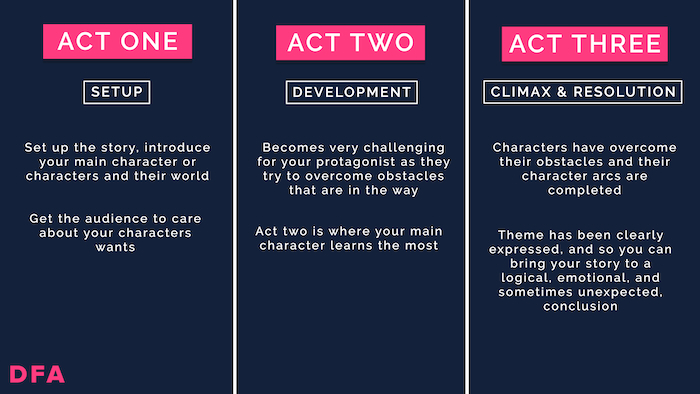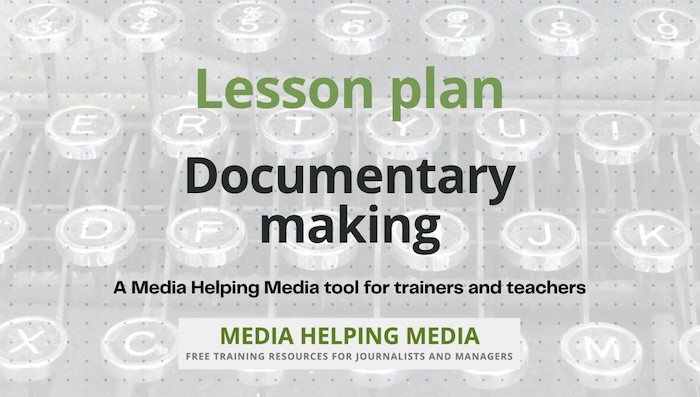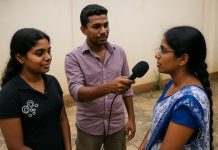
The Documentary Film Academy has produced a free step-by-step guide for journalists who want to learn how to make documentaries.
In an introduction to the process, award-winning documentary filmmaker Sebastian Solberg has set out his 12 “essential steps” from researching the topic you want to cover to promoting the finished product. The article below is taken from the Documentary Film Academy site and published here with Sebastian’s permission.
Documentary making – a step-by-step guide
Starting your journey in documentary filmmaking can often feel overwhelming. It can be challenging knowing where to start. So here are my 12 essential steps for making a documentary, filled with practical advice and insider tips to help you turn your idea into a compelling film.
You don’t have to be a professional to make a documentary film. In fact, I started out with no experience and a lot of questions. Since then I’ve gone on to create documentaries that have won awards, sparked social change, and attracted high-paying clients (you can check out my work here). And that’s why I founded the Documentary Film Academy in order to help beginners make their first documentary film.
1. Documentary rearch
The best documentaries are the ones that come from a personal place. So, before anything else, you need to find a story idea that gets you excited and has interesting characters.
Do some initial research online and in your local libraries and bookstores to get an idea of what’s out there. But don’t just read about stories, watch them too. Not only will this give you a better understanding of the kinds of films that excite you, but you’ll also get some great ideas for your own project.
2. Choose a documentary narration style
There are many ways to categorise documentaries.
For example, film critic and theorist Bill Nichols categorised documentaries into six modes – poetic, expository, observational, participatory, reflexive and performative.
Nichols’ modes are written from an academic perspective and overlap narration style with subject matter and visual techniques. I think it is simpler to explain each of these elements separately.
So, instead, I have simplified Nichols’ modes down into four categories focussing purely on narration style as the distinguishing factor.
So, let’s get into it, here are the four main narration styles I use, when making a documentary:
- Interview-led documentaries are based on interviews with the key people involved in the topic of the film. This type of documentary is typically used to explore a particular issue or event in depth.
- Presenter-led documentaries are narrated by a presenter, who guides the viewer through the story. They can be used to tell any kind of story, from historical dramas to travel vlogs.
- Observational-led documentaries are filmed entirely as if the viewer is an unseen observer, with no voiceover narration or interviews. This type of documentary is often used to capture reality in unscripted situations.
- Narrator-led documentaries use a narrator to guide the viewer through the film, often providing additional information and insights that wouldn’t be possible in an observational or interview-led documentary.
It’s important to remember that often documentary films take elements from at least two, if not more of these styles. So when you’re looking for the best way to tell your story, don’t feel you’re limited to just one way of doing it.
Discover the pros and cons of each narration style here: Documentary Storytelling: Narration Style
3. Use a three-act documentary structure
Now that you have a good understanding of the documentary filmmaking process, it’s time to start thinking about your story. The best way to start is by using the Three-act Structure.
The Three-act Structure is a classic storytelling model that divides your documentary into three parts: Act 1 (Setup), Act 2 (Development), and Act 3 (Climax & Resolution). Each part has its own set of goals, which will help you map out the structure of your documentary.
For the beginning, your goal is to introduce your main characters and setting, and set up the conflict that will drive the rest of the film. In the middle, you’ll explore the conflict in more depth, and introduce new characters and subplots. And for the end, you’ll resolve the conflict and tie up all of the loose ends.
Dive deeper into documentary structure here: Master the Art of Documentary Storytelling in Three Acts

4. Find your documentary crew
Once you have your idea and equipment, the next step of documentary filmmaking for beginners is to find your team. You need to start assembling a group of like-minded individuals who are passionate about the topic you have chosen and can help make your project a success.
When looking for crew members, it’s important to consider what skills and insight they can bring to the project. Are you looking for an editor? A sound recordist? A cinematographer? All of these people play a key role in creating a successful documentary film.
Learn more about how to find your film crew here: How to Find a Film Crew to Help You Make Your Documentary
5. Create a documentary treatment
After you have thoroughly researched the topic of your documentary and gained a well-rounded understanding of it, you can then begin putting together a treatment.
Creating a treatment involves outlining the central focus and narrative of your documentary. It should include the main characters, key themes, what type of footage you want to capture, and any other information necessary to illustrate your vision.
A well-thought-out treatment is essential in helping you to organise your filming process, as it serves as an effective roadmap for when it comes time to begin shooting. It also gives potential crew members or collaborators an idea of what your documentary is going to look and feel like once it’s completed.
You can learn more about how to create a documentary treatment here: How to Create a Compelling Documentary Treatment
6. Create a documentary schedule & budget
With the research and planning phase complete, it’s time to create and stick to a schedule and budget. This is one of the most important steps in documentary filmmaking and sets the foundation for the rest of your project.
To put together your documentary schedule, break down each stage of production into manageable tasks that you can easily tackle in a set amount of time. Use any deadlines that are already in place as benchmarks, then plan out all necessary tasks from pre-production to post-production.
For creating your budget, consider things such as equipment rental, personnel costs, legal fees, travel expenses, etc. Make sure you add 10% of the total budget for any unexpected costs that may come up along the way. Having an estimated budget plan will help ensure you stay on track and on budget throughout production.
7. Choose camera equipment for your documentary
I’ve seen so many filmmakers starting out getting completely stressed out about what camera to buy to help them make their documentary and they hope it’s going to be a shortcut to improving their skills and validating themselves as a filmmaker.
But the truth is, and I’m sure you’ve heard this before, it’s far more important to master your skills as a filmmaker than invest in an expensive camera. So use whatever camera you have available to you, whether that a mobile phone or your friends Mirrorless camera.
8. Start shooting your documentary
Once you’ve finished your preparation, it’s time to start filming. As you film, be sure to get a variety of shots from different angles and distances. I like to use something called the five-shot rule to help with this:
- So first up you’ll want to film a close-up of your subject’s hands to show what is being done.
- Then film a close-up shot of your subject’s face.
- Then a wide shot shows where the scene is taking place.
- Then an over-the-shoulder shot of your subject.
- And lastly, an unusual shot to show the scene unfolding – it’s up to you what camera angle you use. Just be creative with it, whether that means climbing up a tree to get a high angle, crawling on your belly to get a low angle or tilting your camera to get a dutch angle.
Using the five-shot rule will help you decide what angles to use when filming a scene, it’s especially useful if you have limited time to film. Once you’ve mastered the five-shot rule, you can add, subtract and mix up the angles you use when filming a scene and start to develop your own visual style.
Keep in mind that even if your footage isn’t perfect, don’t worry – that’s what editing is for. The goal here is just to capture enough material to make sure you can tell your story in the most compelling way possible.
9. Write a paper edit for your documentary
The next step in the documentary filmmaking process is to write a paper edit. This is the process of watching all of the footage you’ve shot and creating a paper edit. A paper edit is simply a written document that outlines the structure of your documentary film and includes notes about each scene. It’s also where you can make notes about transitions, music, and sound.
Writing a paper edit can be time-consuming but it’s an essential part of the filmmaking process. It will help you to stay organized and ensure that you have all of the footage you need for your documentary film before moving on to the editing stage.
10. Begin editing your documentary
Once you have all of your footage, it’s time to begin editing your documentary. This is where all the pieces and parts of your film come together to tell the story you want to tell. The process can be broken down into four steps: importing elements into the editing software, adding beats to the timeline, building the framework of your film, and refining and re-editing.
When you begin editing, start by importing all of your footage into your preferred editing software (I use Adobe Premiere Pro). Once your elements are inside, you’ll want to get familiar with each clip and start building an overall structure for the documentary. As you work through this step, consider where each beat should go using the three-act structure and what order they should be presented in to create a compelling story.
Once you have a basic framework built out onto the timeline, it’s time to refine and re-edit the film until it’s ready for its big debut!
Dive deeper into documentary editing: 6 Steps to Editing a Powerful Documentary
11. Colour grade, choose music & design soundscape for your documentary
The next step in the documentary filmmaking process is colour grading, music, and sound design. Once you’ve finished editing your film and have picture lock, it’s time to give your documentary its final touch.
Colour grading can make a huge difference in the look of your film by enhancing certain elements or creating a unique tone. With colour grading, you can manually adjust the colours of your video to give it a desired look and feel.
After colour grading comes music and sound design. You can find existing music or work with a composer to create a bespoke score for your documentary—and don’t forget about sound effects. Sound design is essential for setting the mood and creating an immersive experience. This could mean adding ambiance or creating sound effects from scratch.
12. Market & share your documentary film
When you have your documentary all finished and ready to go, the next step is to get it out there. You’ll want to start marketing your documentary using social media, email blasts and other forms of outreach. Generating buzz around your film is key to getting people interested in watching it.
Next, you should consider submitting your film to festivals or putting it online for people to watch. There are a few different options available when it comes to streaming services like Netflix, Amazon Prime or Vimeo, offering different levels of exposure and royalties. It all depends on what your end goal is with the film. Do you want as many people as possible to see it? Or do you want to make money from it? Knowing this will help you decide which distribution route is best for you.
Documentary filmmaking checklist
Making your first documentary can be tough with so much to do and plan. It’s easy to get lost and hard to know what to do next.
That’s why I’ve created an easy-to-follow documentary filmmaking checklist. You can access it here: Documentary Filmmaking Checklist – after clicking that link you will be asked to submit your name and email address and the checklist will be sent to you.
By Sebastian Solberg

Questions
- What is the first step in the documentary filmmaking process?
- Describe the role of a presenter in a presenter-led documentary.
- Explain the purpose of using a three-act structure in documentary storytelling.
- Identify two key considerations when assembling a documentary film crew.
- What is a documentary treatment, and why is it important?
- How does the five-shot rule assist filmmakers during the shooting process?
- Discuss the significance of a paper edit in the documentary filmmaking process.
- What are the four steps involved in the editing process of a documentary?
- How can colour grading enhance the visual appeal of a documentary?
- What factors should a filmmaker consider when deciding on the distribution route for their documentary?
Answers
- The first step in the documentary filmmaking process is documentary research.
- In a presenter-led documentary, the presenter narrates the story and guides the viewer through the film.
- The three-act structure helps organise the documentary into a coherent narrative with a setup, development, and resolution.
- When assembling a documentary film crew, consider the skills and insight each member can bring and their passion for the topic.
- A documentary treatment outlines the central focus and narrative, serving as a roadmap for filming and providing collaborators with a vision of the final product.
- The five-shot rule helps filmmakers capture a variety of angles and shots, ensuring comprehensive coverage of a scene.
- A paper edit organises footage and notes about scenes, transitions, music, and sound, ensuring all necessary material is available before editing.
- The four steps in the editing process are importing elements, adding beats to the timeline, building the framework, and refining and re-editing.
- Colour grading enhances a documentary by adjusting colours to create a desired look and feel, adding to the film’s visual appeal.
- Filmmakers should consider their goals, such as audience reach or revenue generation, when choosing a distribution route for their documentary.
Lesson plan for trainers
If you are a trainer of journalists we have a free lesson plan: ‘Documentary making‘ which you are welcome to download and adapt for your own purposes.









